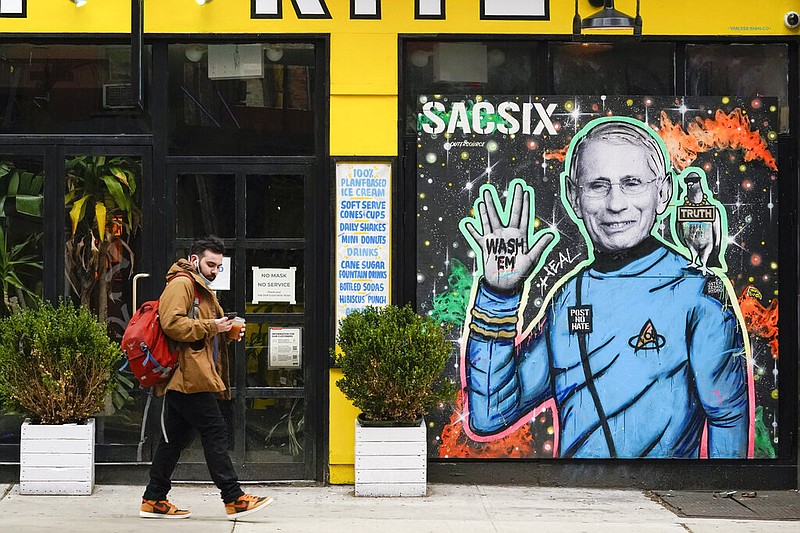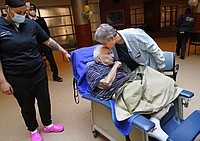Coronavirus cases are rising again in the United States. The rate of deaths is still decreasing, but the country averaged 61,545 new cases per day last week, 11% more than the average two weeks earlier.
Scientists predicted weeks ago that the number of infections would curve upward again in late March, at least in part because of the rise of variants of the coronavirus across the country.
[Video not showing up above? Click here to watch » https://www.youtube.com/watch?v=cZF5jRqmXhI]
Dr. Anthony Fauci, the Biden administration's chief science adviser, said Sunday on CBS' "Face the Nation" that the rise in infections also resulted from state leaders pulling back on mitigation measures and from large social interactions, such as spring break gatherings in Florida.
"The variants are playing a part, but it's not completely the variants," Fauci said.
Most states have lifted restrictions, including on indoor dining, in response to the drop in numbers, actions that Fauci called "premature."
As of Thursday, there were 8,337 known U.S. cases of the variant form B.1.1.7 that was first seen in Britain, but the actual number is probably much higher because labs in the country analyze only a very small proportion of the diagnosed cases. Still, the trend is clear: The variant -- which is more transmissible -- has been rising exponentially in the United States, its growth masked by the overall drop in infections.
[Gallery not loading above? Click here for more photos » arkansasonline.com/329covid19/]
"It is remarkable how much this recalls the situation last year where we had introductions of virus to different places that scientists warned would be a problem," Bill Hanage, a public health researcher at the Harvard T.H. Chan School of Public Health, said in an interview Sunday. "People waited for them to be a problem before they took action -- and then too late, they took action."
Hanage said he was particularly worried about B.1.1.7 because it is at least 50% more transmissible than the original virus. The brisk pace of vaccinations will stem the tide somewhat, he added.
The vaccines in use in the United States -- made by Pfizer-BioNTech, Moderna and Johnson & Johnson -- are expected to prevent severe disease and death from any of the variants, though they are slightly less effective against a variant that was identified in South Africa. That variant, known as B.1.351, has not yet spread widely in the United States.
Because many of the highest-risk people have been inoculated, hospitalizations and deaths may not show a steep rise along with infections. But a surge in cases will still lead to some severe cases and deaths, Hanage said.
"How large it will be, we'll need to wait and see," he said. "But ideally, we would not be waiting to see. Ideally, we'd be taking action."
Asked Sunday what's going wrong in the U.S. as cases rise, President Joe Biden told reporters: "Based on what I'm hearing, apparently people are letting their guard down." Biden said he hopes to have a better sense of the situation after a meeting with his White House pandemic team today.
Experts worry that members of the public is getting the message that increased vaccination means they're in the clear, even though only a fraction of the public has completed a full course. Vaccines lessen the risk of severe illness or death from covid-19, but scientists are still studying how well they prevent the spread of the virus.
"To allow larger groups to gather, to give the message to the public that we're over the worst and that we can go back to normal is a mistake," said Bruce Farber, chief of infectious diseases and public health and epidemiology for Northwell Health.
STATES' SURGE
Two states experiencing a surge of cases are New York and New Jersey, which are back atop the list of U.S. states with the highest rates of infection a year after becoming a global epicenter of the coronavirus pandemic.
Even as the vaccination campaign has ramped up, the number of new infections in New Jersey has crept up by 37% in a little more than a month, to about 23,600 every seven days. About 54,600 people in New York tested positive for the virus in the past week, a number that has begun to inch up recently.
The two states now rank No. 1 and 2 in new infections per capita among U.S. states. New Jersey has been reporting about 647 new cases for every 100,000 residents over the past 14 days. New York has averaged 548.
Neither New York nor New Jersey is experiencing anything like what was seen last spring, when hospitals -- and morgues -- were overflowing. And like the rest of the country, both are in a much better place than in January, at the peak of the pandemic's winter spike.
But the lack of improvement in recent weeks has raised concerns that the states are opening too quickly and that people are letting down their guard too much, just as potentially more contagious variants of the virus are circulating more widely.
In February, New York Gov. Andrew Cuomo allowed the state's largest stadiums to host sporting events and concerts again, albeit at only 10% of normal capacity. New York City movie theaters have been allowed to reopen. Restaurants can now operate at 50% capacity in New York City and 75% capacity elsewhere in the state. Indoor fitness classes have resumed, too.
New Jersey Gov. Phil Murphy has led a similar reopening, with the state's restaurants also allowed to operate at half capacity and barbers, salons and other personal care businesses resuming trade.
That's happened in other parts of the country, too.
Utah, Alabama, Arkansas and Indiana plan to soon end mask mandates, joining states including Arizona, Texas, Mississippi, Montana and Iowa that have eliminated face covering requirements in recent weeks. Some states are allowing businesses to operate at full capacity.
But Murphy said in recent days that he is hitting pause on further loosening of the rules because of New Jersey's virus resurgence.
The number of people hospitalized with the virus in New York has plateaued around 4,600 since mid-March. New Jersey hospitals are reporting about 2,200 virus patients -- up by roughly 300 in the past couple of weeks.
Experts cite several potential factors, including the spread of potentially more contagious variants in the densely populated region.
"Is there something different that's happening in this part of the country compared to some other parts of the country?" asked Dr. Ed Lifshitz, the medical director of New Jersey's communicable disease service within the state Health Department. "And the answer is probably yes."
New York City Mayor Bill de Blasio has questioned whether Cuomo is easing restrictions "for political reasons," despite cause for concern about the virus numbers. The governor is facing calls for his resignation over sexual harassment allegations.
But then de Blasio himself announced that 80,000 more city employees would no longer work from home, starting in May.
New York City's Public Advocate Jumaane Williams urged New York to pause reopening plans.
"I ask the governor to stick to the science, trust the experts and pause the planned reopenings now, before they take effect and more are infected," Williams said.
DOSES IN TEXAS
Meanwhile, Texas is set to begin making covid-19 vaccinations available today to anyone who wants one.
Texas will become the most populous U.S. state to expand covid-19 vaccine eligibility to all adults. The state has nearly 30 million residents.
This will come more than a month before Biden's goal of opening vaccine eligibility to everyone by May 1.
In Texas, individuals who are 16 and 17 years old will also be able to get vaccinated starting today. But the Texas Department of State Health Services said only the Pfizer vaccine is authorized for individuals in that age group.
Alaska was the first state to open up vaccine eligibility to all adults.
Texas has one of the nation's slowest vaccination rates. About 12% of the state's population had been fully vaccinated as of Saturday, and about 24% had received at least one dose, according the U.S. Centers for Disease Control and Prevention. In comparison, neighboring New Mexico has fully vaccinated more than 21% of its population and given at least one dose to 36% of its residents.
More than 10 million coronavirus vaccinations have been administered in Texas, according to state health officials.
Texas reported 2,285 new confirmed and probable covid-19 cases on Sunday, as well as 63 additional deaths. New cases have continued to drop in the state. Over the past two weeks, the rolling average of daily new cases in Texas has lessened by 675.9, a decrease of 14.8%, according to data from Johns Hopkins University.
Information for this article was contributed by Apoorva Mandavilli of The New York Times; and by Marina Villeneuve, Mike Catalini and Kevin Freking of The Associated Press.


